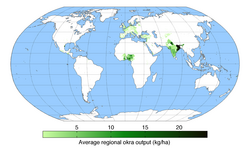Okra

| Okra | |
|---|---|
 | |
| Okra flower bud and immature seed pod | |
| Scientific classification | |
| Kingdom: | |
| Division: | |
| Class: | |
| Order: | |
| Family: | |
| Genus: | |
| Species: | A. esculentus |
| Binomial name | |
| Abelmoschus esculentus | |
 | |
| Worldwide okra production | |
| Synonyms | |
| Hibiscus esculentus L. | |
Okra (Abelmoschus esculentus) are known in many English-speaking countries as lady's fingers or gumbo) is a flowering plant in the mallow family, related to cotton and hibiscus.[1] Okro is native to West Africa. The word (Okro) came from the Igbo Language (South Eastern Nigeria) where okra vegetable is known as "Okro" or “Okworo”. The name adulteration began as the British colonialists came to Southern Nigeria and discovered its great health benefits. The problem was they could not pronounce the Igbo word “Okworo”, so they called it “Okro/Okra” and later, helped export and popularise the vegetable in Europe and in many warm regions across the globe. It is valued for its edible green seed pods which has many health benefits. It is grown for the pods, which are harvested in the immature stage and used in salads, soups and dishes.[2] It is a national vegetable in many West African countries like Nigeria and Ghana, and in Asian countries like India and Pakistan. Some of the ways it is eaten are fried, grilled, or in soup. [3]
References[change | change source]
- ↑ National Research Council (2006-10-27). "Okra". Lost Crops of Africa: Volume II: Vegetables. Lost Crops of Africa. Vol. 2. National Academies Press. ISBN 978-0-309-10333-6. Retrieved 2008-07-15.
- ↑ "9 Amazing Health Benefits of Okra". www.nutritionfox.com. 25 November 2015. Retrieved 25 January 2016.
- ↑ "Okra has an interesting food history". The Daily Progress. Retrieved 2022-03-18.